The post-war era marked a turning point in the history of Filipino culture. After World War II, the Philippines experienced a wave of change that reshaped its artistic landscape. This period became a catalyst for innovation, blending traditional forms with modern influences.
Music, as a universal art, played a vital role in expressing the nation’s identity. Composers and artists drew inspiration from both local traditions and global trends. This fusion created a unique sound that resonated with the Filipino spirit.
The post-war years also saw the rise of new genres and styles. From folk-inspired songs to contemporary compositions, this era laid the foundation for future generations. It was a time of creativity and resilience, reflecting the nation’s journey toward recovery and progress.
Key Takeaways
- The post-war era was a transformative period for Filipino music.
- Traditional and modern influences blended to create unique sounds.
- Composers played a key role in shaping the nation’s musical identity.
- Music became a powerful medium for cultural expression.
- This era set the stage for future innovations in Filipino art.
Historical Context of the Post-War Era in the Philippines
The aftermath of World War II brought profound changes to the Philippines. The war left the nation in ruins, with over a million lives lost and widespread destruction. This period of devastation also became a catalyst for rebuilding and renewal.
Societal and political structures underwent significant shifts. The Philippines gained independence on July 4, 1946, marking a new chapter in its history. The Rehabilitation Bill provided funds for reconstruction, helping to restore infrastructure and revive the economy.

Impact of WWII on Filipino Society
World War II deeply affected everyday life in the Philippines. Families were displaced, and communities struggled to recover. The war also influenced artistic expression, as people sought ways to process their experiences.
Musicians played a crucial role during this time. They used their craft to express emotions and document the nation’s journey. Traditional music became a source of comfort and a way to preserve cultural identity.
Cultural Rebirth After Conflict
The post-war era saw a cultural revival in the Philippines. Artists and writers explored new themes and styles, blending traditional elements with modern influences. This creative surge reflected the nation’s resilience and determination to rebuild.
Historical notation and theory developments in the 20th century also shaped this period. Musicians and composers experimented with new techniques, creating a unique sound that resonated with the Filipino spirit.
| Aspect | Impact |
|---|---|
| Societal Changes | Shift in family structures and community dynamics |
| Political Changes | Independence and new governance models |
| Cultural Revival | Blending of traditional and modern artistic forms |
| Role of Musicians | Healing and identity expression through music |
This era laid the foundation for future innovations in Filipino art and culture. It was a time of creativity, resilience, and hope, reflecting the nation’s journey toward recovery and progress.
Evolution of Musical Styles and Influences
The fusion of indigenous and Western elements reshaped the Filipino auditory identity in the post-war years. This period saw a unique blend of traditional rhythms and modern melodies, creating a sound that resonated deeply with the nation’s cultural spirit.
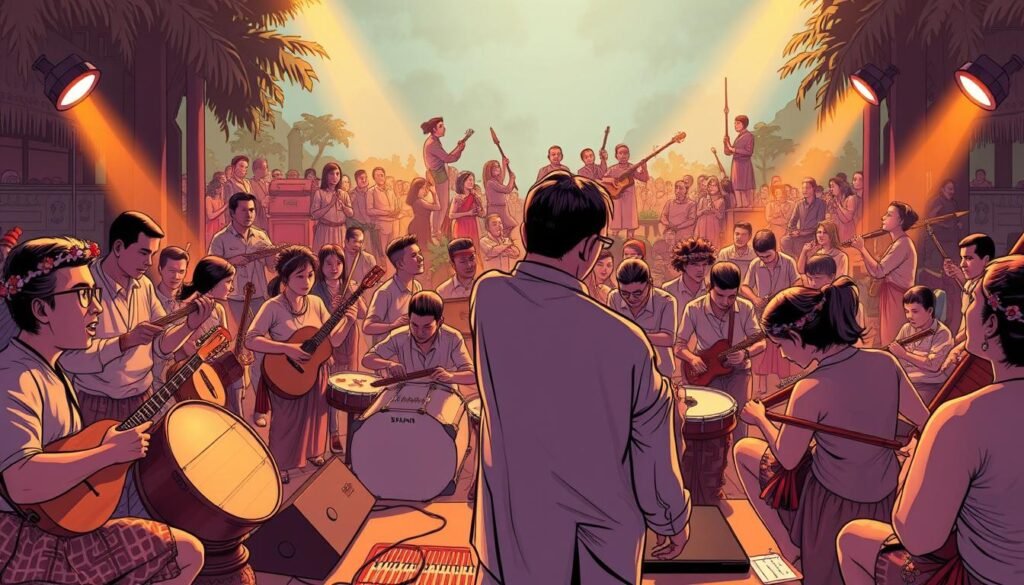
Traditional Philippine Sounds
Traditional music in the Philippines is rooted in indigenous scales and instruments. Instruments like the kulintang and kudyapi played a vital role in shaping the nation’s early soundscapes. These tools were not just for entertainment but also for storytelling and community bonding.
The rhythm and melody of these compositions reflected the daily lives and values of the Filipino people. Traditional forms often featured repetitive patterns, creating a hypnotic and communal listening experience.
Emergence of Western Elements
Western influences began to seep into Filipino compositions during the post-war era. Classical music introduced new techniques like harmony and notation, which composers eagerly adopted. This blend of styles gave rise to a hybrid form that was both familiar and innovative.
Composers like Lucio San Pedro and Antonio Molina played a pivotal role in bridging these traditions. They skillfully merged the sound of native instruments with the structure of Western compositions, creating a unique musical identity.
| Period | Musical Style | Key Features |
|---|---|---|
| Pre-War | Indigenous Sounds | Use of native instruments, repetitive rhythms |
| Post-War | Hybrid Compositions | Blend of traditional and Western elements |
| Modern Era | Contemporary Fusion | Integration of global trends with local traditions |
This evolution highlights the resilience and creativity of Filipino artists. By embracing both their roots and external influences, they crafted a sound that continues to inspire generations.
The Role of Cultural Identity in Filipino Music
Cultural identity has always been a cornerstone of Filipino artistic expression. It serves as a powerful marker of national pride, connecting people to their roots and shared experiences. Through tradition, Filipinos have preserved their values, passing them down through generations in the form of songs and melodies.
Filipino music reflects the daily life and emotions of its people. It captures the joys, struggles, and aspirations of individuals, making it deeply personal yet universally relatable. This connection between the person and their culture is what makes it so impactful.
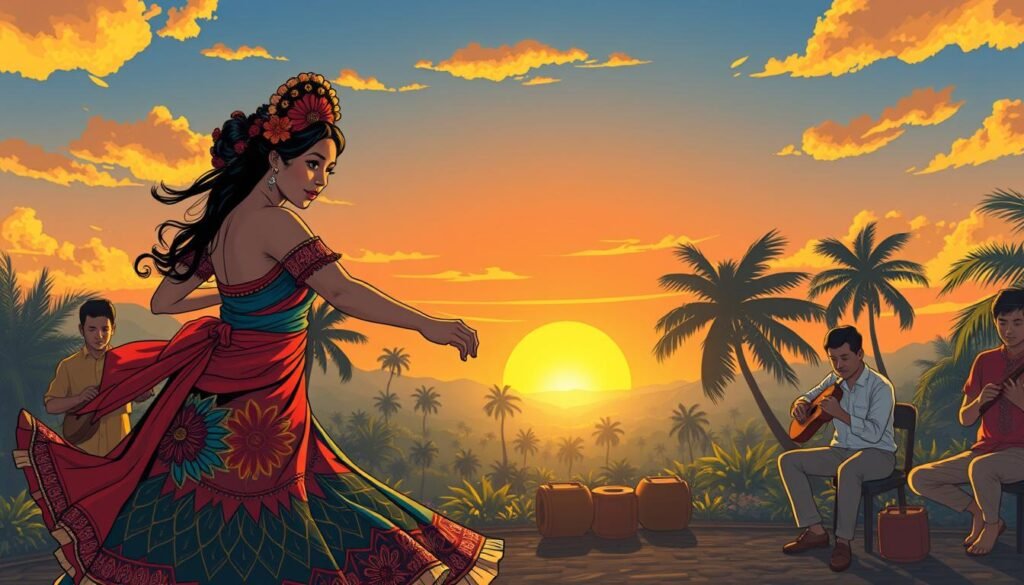
The emotional and symbolic value of music is evident in its role in Filipino society. From festive celebrations to solemn rituals, it weaves through every aspect of life. It is not just entertainment but a way to express identity and preserve heritage.
Filipino composers have skillfully blended tradition with modern influences, creating a unique sound that resonates globally. This evolution reflects the nation’s ability to adapt while staying true to its roots. For a deeper dive into Filipino cultural practices, explore ancient Filipino scripts.
In essence, music is more than just art—it is a reflection of the Filipino spirit. It tells stories, connects communities, and keeps culture alive. As the world evolves, so does the sound of the Philippines, but its heart remains rooted in tradition.
Incorporating Traditional Instruments and Modern Technology
The blending of traditional instruments with modern technology has reshaped Filipino soundscapes. This fusion has allowed artists to preserve cultural heritage while embracing innovation. By combining the old and the new, Filipino musicians have created a unique auditory experience.
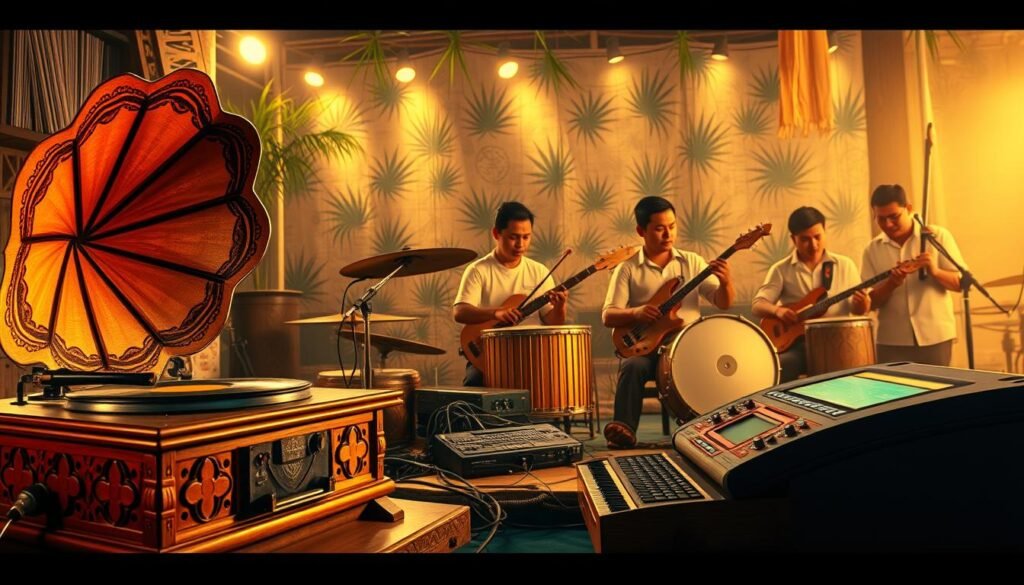
Innovations in Instrumentation
Traditional instruments like the kulintang and kudyapi have been reimagined through electronic modulation. This process enhances their sound, making them adaptable to modern compositions. Artists now use these tools to bridge the gap between cultural roots and contemporary trends.
Digital audio workstations (DAWs) have also played a key role. These platforms allow musicians to layer traditional sounds with modern beats. The result is a rich, dynamic auditory landscape that resonates with both local and global audiences.
Transition to the Digital Era
The shift from analog to digital has transformed how Filipino artists work. Recording techniques have become more accessible, enabling even small-scale musicians to produce high-quality tracks. This democratization of technology has empowered a new generation of creators.
Modern recording tools also allow for greater experimentation. Artists can now use software to tweak sounds, add effects, and create complex arrangements. This flexibility has opened up endless possibilities for musical expression.
“Technology has given us the tools to honor our past while shaping our future.”
These advancements have not only changed how music is made but also how it is shared. Online platforms have made it easier for Filipino artists to reach a global audience. This connectivity ensures that the nation’s musical instrument traditions continue to thrive in the digital age.
Pioneers and Key Figures in Filipino Music
The post-war period in the Philippines saw the rise of iconic figures who shaped the nation’s artistic identity. These musicians and composers played a pivotal role in blending traditional sounds with modern influences. Their work not only defined Filipino music but also brought it to the global stage.
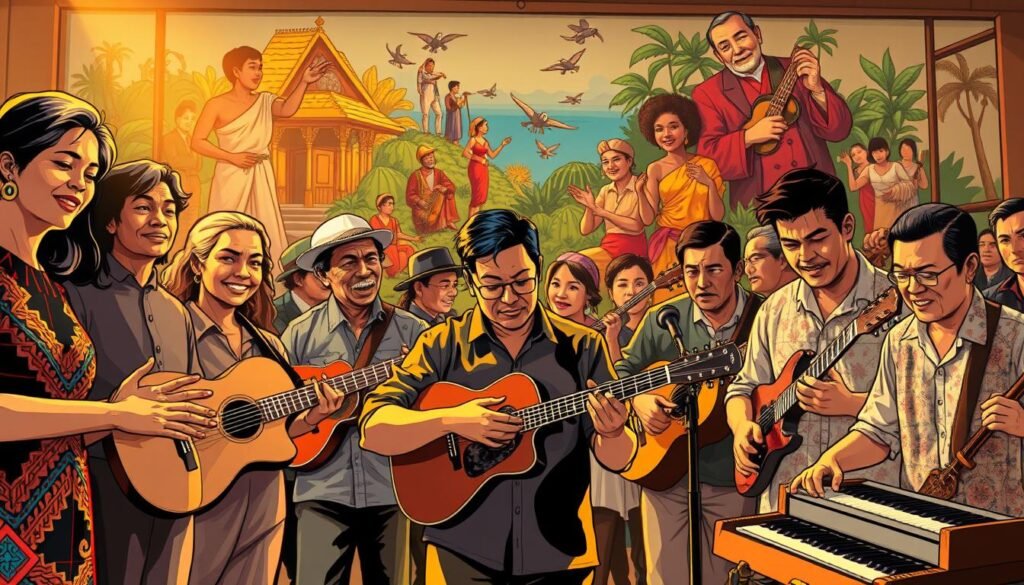
Local Iconic Musicians
Lucio San Pedro stands out as one of the most influential composers of his time. Known for works like “Sa Ugoy ng Duyan,” he captured the essence of Filipino culture. His compositions often drew inspiration from nature and personal experiences, creating a deep emotional connection with listeners.
Another notable figure is Levi Celerio, a prolific singer and lyricist. His collaborations with San Pedro produced timeless pieces that continue to resonate today. These artists not only preserved traditional sounds but also introduced innovative techniques that shaped modern Filipino music.
International Collaborations
Filipino musicians have also made their mark on the global stage. Lucio San Pedro’s studies at the Juilliard School in New York allowed him to blend Western techniques with Filipino traditions. This fusion created a unique sound that appealed to both local and international audiences.
Collaborations with global artists further expanded the reach of Filipino music. These partnerships showcased the versatility of Filipino musicians and their ability to adapt to diverse styles. Such efforts have helped elevate Filipino music to a prominent position in the global art scene.
These pioneers not only enriched the nation’s musical heritage but also inspired future generations. Their legacy continues to influence Filipino artists, ensuring that the spirit of innovation and cultural pride remains alive.
Influence of Global Musical Trends on Local Sounds
Global musical trends have significantly influenced the evolution of Filipino soundscapes. The exchange of ideas across borders has enriched local compositions, creating a unique blend of traditional and modern styles. This interplay has shaped the way Filipino artists use their craft to express cultural identity.
International scales and structures have played a key role in this transformation. Filipino composers have adopted techniques from Western classical and contemporary genres, integrating them with indigenous rhythms. This fusion has resulted in a dynamic type music that resonates with both local and global audiences.
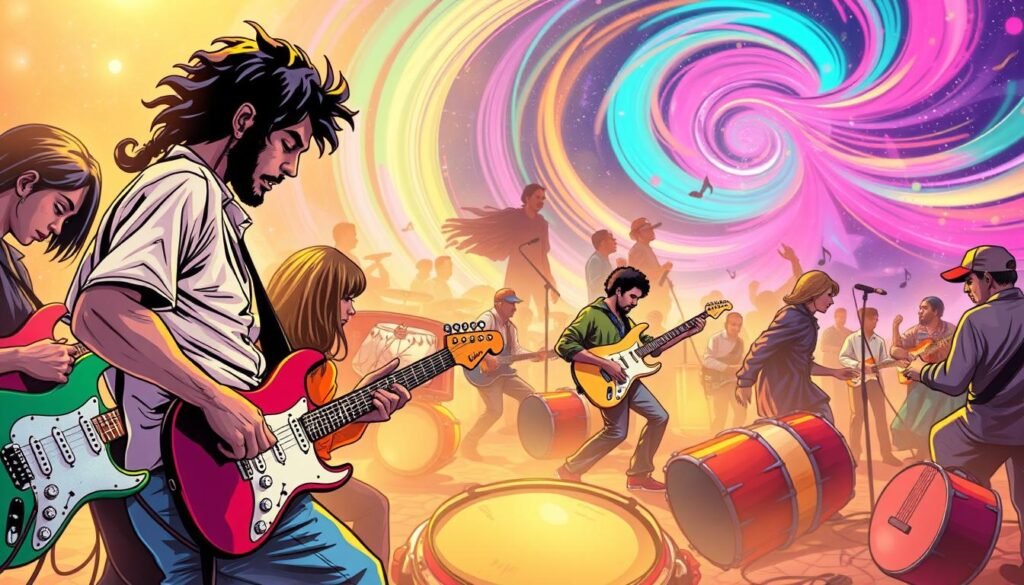
Cross-cultural exchanges have further deepened this influence. Collaborations between Filipino artists and international musicians have introduced new sounds and perspectives. For example, the integration of Latin beats and K-pop elements into Filipino pop songs showcases this creative adaptation.
Global trends have also impacted popular culture in the Philippines. Streaming platforms have made it easier for listeners to access diverse genres, from Afrobeats to Reggaeton. This exposure has inspired Filipino artists to experiment with new styles, enriching the nation’s musical landscape.
| Global Trend | Local Adaptation |
|---|---|
| Latin Beats | Filipino pop songs with salsa rhythms |
| K-pop Elements | Incorporation of Korean pop structures |
| Afrobeats | Use of African drum patterns in local tracks |
The use of global influences has not diluted Filipino traditions but rather enhanced them. By blending international trends with local sounds, artists have created a vibrant and evolving musical identity. This fusion reflects the nation’s openness to the world while staying rooted in its heritage.
In conclusion, the influence of global musical trends has enriched Filipino soundscapes. It has allowed artists to explore new creative possibilities while preserving their cultural essence. This exchange continues to shape the future of Filipino artistry, making it a vital part of the world’s musical tapestry.
Jazz, Rock, and Alternative Movements in the Philippines
The post-war years introduced a wave of new sounds to the Philippines, reshaping its artistic identity. Jazz, with its improvisational style and rich harmonies, became a symbol of cultural renewal. This genre brought a fresh tone to Filipino compositions, blending traditional rhythms with modern influences.
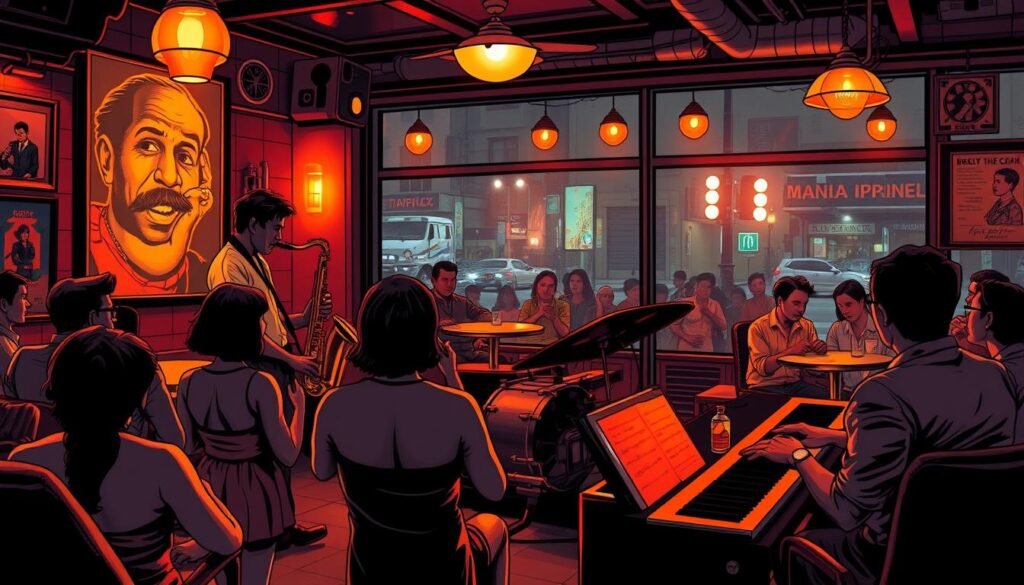
Rock and alternative movements soon followed, challenging traditional musical paradigms. Bands like the Juan de la Cruz Band pioneered Pinoy rock, experimenting with bold chord progressions and electrifying performances. These genres not only captivated local audiences but also paved the way for a diversified musical culture.
Post-War Jazz Emergence
Jazz found its footing in the Philippines during the 1950s, influenced by American artists and global trends. Its unique tone and rhythmic complexity resonated with Filipino musicians, who adapted it to reflect local themes. Iconic performances in Manila’s clubs showcased the genre’s versatility and emotional depth.
Composers like Lucio San Pedro incorporated jazz elements into their works, creating a hybrid sound that appealed to both traditional and modern listeners. This fusion highlighted the adaptability of Filipino artists and their ability to innovate while staying true to their roots.
Rock and Alternative Movements
By the 1960s, rock music had taken the Philippines by storm. Bands like The Dynasonics, often called the “Pinoy Beatles,” brought a new energy to the scene. Their experimental use of chord structures and dynamic performances redefined Filipino soundscapes.
The 1970s saw the rise of the Manila Sound, blending rock with disco, funk, and jazz. Songs like “Anak” by Freddie Aguilar became cultural milestones, earning international recognition. These movements not only entertained but also provided a platform for social commentary and self-expression.
In the 1980s and 1990s, alternative bands like Eraserheads and Rivermaya gained mainstream success. Their innovative styles and relatable lyrics connected with a new generation, solidifying rock’s place in Filipino culture.
These genres challenged traditional norms, encouraging artists to explore new creative possibilities. They also fostered a sense of unity, bringing people together through shared experiences and a love for jazz, rock, and alternative sounds.
The Main Keyword Spotlight: Music in Filipino Culture
Filipino culture thrives on its ability to blend tradition with innovation. At its core, artistic expression serves as a bridge between the past and the present. This is especially true for music, which has long been a vital part of the nation’s identity.
From traditional folk songs to modern compositions, Filipino music reflects the values and experiences of its people. The melody of a song often carries the emotions of a community, while its composition tells a story. This dual role makes it a powerful tool for cultural preservation and innovation.
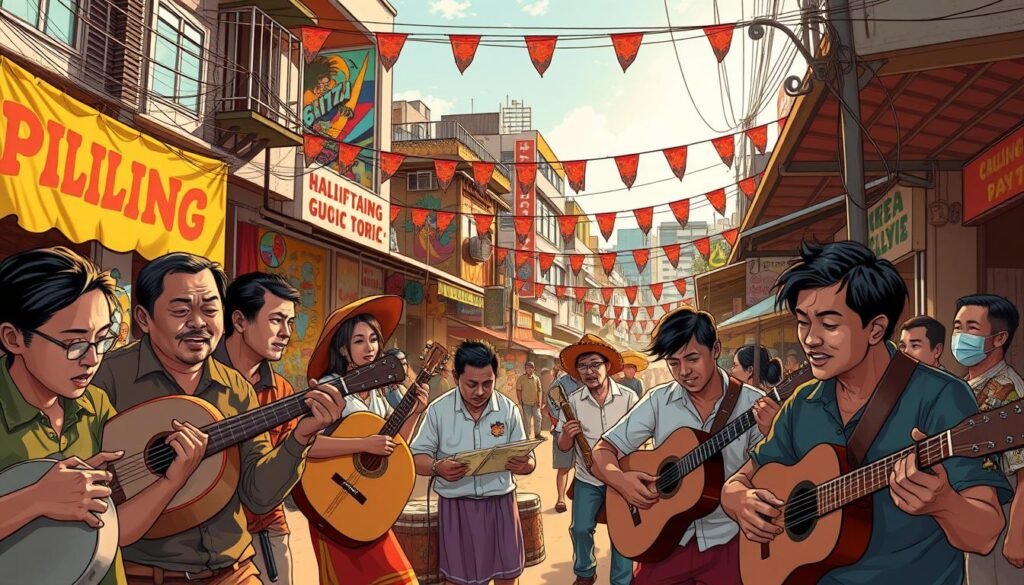
Historical examples, like the use of indigenous instruments, highlight the deep roots of Filipino culture. Contemporary trends, such as karaoke, show how modern technology has embraced these traditions. This blend of old and new ensures that the nation’s artistic heritage remains alive and relevant.
Music also plays a key role in community bonding. Festivals and gatherings often feature performances that bring people together. These events foster a sense of unity and pride, reinforcing the importance of culture in everyday life.
In essence, Filipino composition and melody are more than just artistic elements. They are cultural artifacts that tell the story of a nation. By celebrating these traditions, Filipinos ensure that their heritage continues to inspire future generations.
Impact of Political and Social Change on Music Evolution
Political and social shifts have long influenced artistic expression in the Philippines. These changes often shape the harmony and themes of compositions, reflecting the nation’s evolving identity. From the struggle for independence to modern-day activism, Filipino artists have used their craft to document and respond to societal transformations.
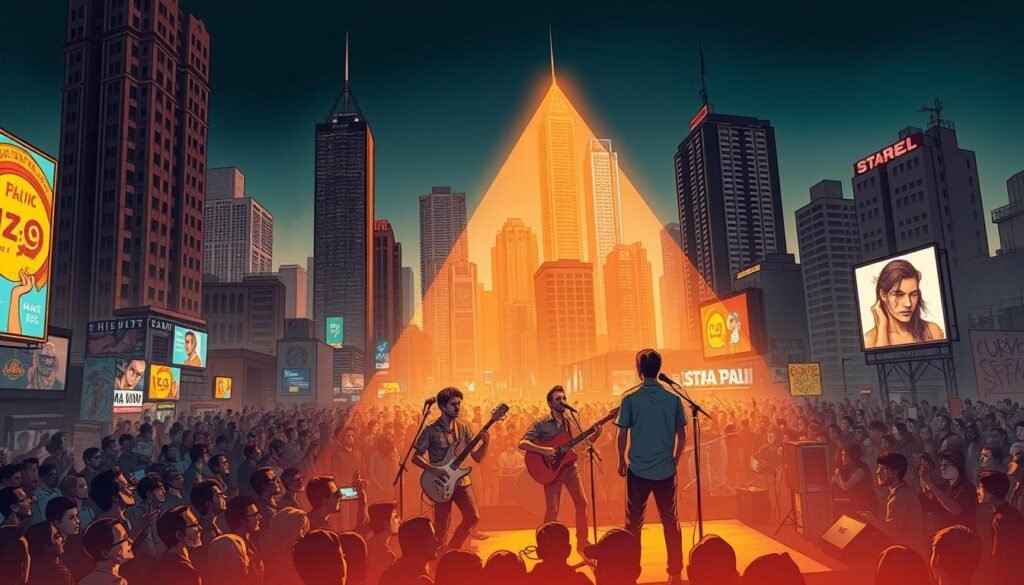
Social Movements and Musical Expression
Social movements have played a pivotal role in shaping Filipino soundscapes. During the civil rights era, artists like Bob Dylan and Joan Baez inspired global audiences with their protest songs. Similarly, Filipino composers integrated theory and practice to create pieces that resonated with local struggles.
The integration of various elements in response to societal shifts is evident in the works of Filipino artists. For example, the use of traditional instruments alongside modern chord progressions symbolizes the blending of old and new. This fusion not only preserves cultural heritage but also adapts it to contemporary contexts.
Case studies, such as the Staple Singers’ transition from gospel to soul, highlight how social movements inspire innovation. Their song “If You’re Ready (Come Go with Me)” directly addressed social obstacles, showcasing the power of artistic expression in advocating for change.
| Movement | Musical Response |
|---|---|
| Civil Rights | Protest songs advocating for equality |
| Anti-War | Lyrics critiquing conflict and violence |
| Modern Activism | Blending traditional and contemporary sounds |
Lyrical content often mirrors historical events, creating a direct connection between art and society. For instance, the anti-war movements of the 1960s and 1970s inspired songs like John Lennon’s “Give Peace a Chance.” These pieces not only entertained but also mobilized individuals toward collective action.
In essence, the evolution of Filipino artistry reflects the nation’s resilience and adaptability. By integrating theory and practice, artists have created a dynamic soundscape that continues to inspire and unite. For more insights on the role of artistic expression in social change, explore this detailed analysis.
Film, Television, and Digital Media’s Role in Music Dissemination
Visual media has become a powerful tool in shaping the way we experience sound. From blockbuster films to streaming platforms, the integration of auditory art with visual storytelling has transformed how we engage with culture. This synergy has not only expanded the reach of sound but also redefined its role in modern society.
Film soundtracks and television themes play a crucial role in promoting sound. Iconic scores, like those in Filipino cinema, often become cultural touchstones. These compositions enhance storytelling, evoke emotions, and leave a lasting impression on audiences. The use of traditional instruments alongside modern performance techniques creates a unique auditory experience.
Digital platforms have emerged as new conduits for sound dissemination. Social media and streaming services allow artists to share their work globally. Platforms like Spotify and YouTube enable independent creators to bypass traditional gatekeepers. This democratization has opened doors for diverse types of sound to reach wider audiences.
The interplay between live performance and recorded media has also evolved. Live streaming services like Instagram Live and YouTube Live bring concerts to fans worldwide. This blend of real-time and recorded experiences enriches the way we connect with sound. It also provides artists with new opportunities for engagement and monetization.
Successful cross-media projects highlight the power of collaboration. For example, Filipino artists have partnered with filmmakers to create soundtracks that resonate globally. These projects showcase the versatility of sound and its ability to transcend cultural boundaries. They also demonstrate how different types of media can amplify artistic expression.
In conclusion, film, television, and digital media have revolutionized the way we experience sound. They have created new avenues for performance, collaboration, and cultural exchange. As technology continues to evolve, so too will the ways in which we share and enjoy sound. For more insights on how technology shapes artistic expression, explore this detailed analysis.
Interplay Between Music and National Identity
The relationship between artistic expression and national identity has always been deeply intertwined in the Philippines. Through melody and rhythm, Filipinos have found a way to express their collective pride and shared experiences. This connection is evident in the way patriotic songs and compositions reflect the nation’s history and values.
National Pride in Sound
Patriotic songs like “Bayan Ko” and “Lupang Hinirang” are more than just compositions. They are symbols of resilience and unity. These pieces use melody to evoke emotions, reminding listeners of the struggles and triumphs that shaped the nation. The culture of the Philippines is deeply embedded in these songs, making them timeless expressions of national pride.
Events and festivals also play a crucial role in reinforcing this identity. During Independence Day celebrations, music becomes a unifying force. Traditional instruments and modern chord progressions blend seamlessly, creating a sound that resonates with both young and old. These moments highlight the power of artistic expression in shaping collective memory.
Music’s ability to mold national identity is unparalleled. It serves as a bridge between the past and the present, preserving history while inspiring future generations. Through its emotional and symbolic value, it continues to foster a sense of unity and pride among Filipinos.
In essence, the interplay between artistic expression and national identity is a testament to the enduring power of culture. It is a reminder that music is not just an art form but a vital part of the Filipino spirit.
Educational Initiatives and Preservation of Musical Heritage
Educational programs have become a cornerstone in safeguarding the Philippines’ rich musical traditions. Through systematic learning, these initiatives ensure that the nation’s artistic legacy is passed down to future generations. Schools and cultural institutions play a vital role in this process, blending traditional practices with modern theory and notation.
Music Education Programs
Contemporary music education programs in the Philippines focus on preserving traditional practices while embracing innovation. Institutions like the University of the Philippines College of Music offer courses that integrate historical composition techniques with modern art forms. This approach ensures that students understand the cultural significance of their craft.
One key aspect of these programs is the emphasis on notation. By teaching students how to document and analyze traditional melodies, educators ensure that these pieces are preserved for future study. This systematic approach helps maintain the integrity of Filipino musical heritage.
Curriculum innovations also play a significant role. Many programs now include workshops on indigenous instruments and folk songs. These hands-on experiences allow students to connect with their cultural roots while developing their skills as performers and composers.
“Education is the bridge between the past and the future, ensuring that our musical traditions remain alive and relevant.”
Another important initiative is the establishment of community-based music schools. These institutions serve as cultural hubs, offering classes and performances that are open to the public. By fostering a sense of community, they encourage local participation in preserving musical heritage.
Digital platforms have also become a valuable tool in music education. Online courses and virtual archives make it easier for students to access resources and learn about traditional practices. This integration of technology ensures that Filipino composition and theory reach a global audience.
In conclusion, educational initiatives are essential in preserving the Philippines’ musical heritage. By nurturing future artists and integrating traditional practices with modern techniques, these programs ensure that the nation’s cultural legacy continues to thrive. For more insights on preserving cultural heritage through technology, explore this detailed analysis.
Festivals and Live Performances as Cultural Showcases
Festivals and live performances have long been a cornerstone of Filipino cultural expression. These events bring communities together, celebrating the nation’s rich artistic heritage. They serve as vibrant platforms for showcasing creativity and fostering unity.
Local Music Festivals
Local music festivals are a vital part of Filipino culture. Events like the Sinulog Festival in Cebu and the Pahiyas Festival in Lucban highlight traditional sounds and modern innovations. These festivals not only entertain but also preserve the nation’s artistic legacy.
Performers and singers play a key role in these celebrations. Their work brings stories to life, connecting audiences to their roots. Through their performance, they inspire pride and cultural appreciation.
Community Concerts
Community concerts provide a platform for emerging talent. These events often feature local artists who blend traditional and contemporary styles. They are a testament to the creativity and resilience of Filipino artists.
Audience interaction is a defining feature of these concerts. The live performance dynamics create a shared experience, fostering a sense of belonging. These moments highlight the power of art in bringing people together.
Notable events like the Manila International Jazz Festival and Wanderland Music & Arts Festival showcase the diversity of Filipino artistry. They bring together different parts of society, celebrating the nation’s cultural richness.
“Festivals are not just events; they are living archives of our culture, connecting us to our past and inspiring our future.”
In conclusion, festivals and live performances are essential in preserving and promoting Filipino cultural heritage. They serve as a bridge between tradition and innovation, ensuring that the nation’s artistic legacy continues to thrive. For more insights on the role of festivals in preserving cultural heritage, explore this detailed analysis.
Analyzing Musical Composition: Rhythm, Melody, and Harmony
Understanding the core elements of composition reveals the depth of Filipino artistry. These elements—rhythm, melody, and harmony—form the foundation of every piece, shaping its emotional and cultural impact. In Filipino traditions, these components are deeply intertwined with storytelling and community bonding.
Traditional Filipino composition often relies on indigenous scales and instruments. The kulintang, for example, creates intricate rhythm patterns, while the kudyapi adds melodic depth. These instruments are not just tools for sound but carriers of cultural narratives.
Modern techniques, on the other hand, blend these traditional elements with contemporary styles. Composers use advanced music notation to document and innovate, ensuring that the essence of Filipino artistry evolves without losing its roots.
Filipino Traditional Notes
Traditional Filipino notes are rooted in indigenous scales, often pentatonic in nature. These scales create a distinct melody that reflects the natural world and daily life. The repetitive rhythm patterns in folk songs, for instance, evoke a sense of unity and continuity.
Indigenous instruments like the gangsa and tongali play a crucial role in shaping these notes. Their unique sounds add texture and depth to traditional compositions, making them instantly recognizable.
Modern Composition Techniques
Modern Filipino composers have embraced global influences while staying true to their heritage. They use advanced music notation to experiment with complex harmony and rhythm structures. This fusion creates a dynamic soundscape that appeals to both local and international audiences.
Digital tools have also revolutionized the creative process. Composers can now layer traditional sounds with electronic beats, pushing the boundaries of Filipino composition. This innovation ensures that the nation’s artistry remains relevant in a rapidly changing world.
In conclusion, the interplay of rhythm, melody, and harmony defines Filipino musical artistry. By blending traditional and modern techniques, composers continue to craft pieces that resonate with the nation’s cultural spirit.
Future Trends in Filipino Music and Innovation
The digital age is reshaping the future of Filipino soundscapes. Emerging technologies are driving a new era of artistic expression, blending tradition with innovation. From digital recording to live performances, these advancements are transforming how Filipinos create and experience sound.
Role of Technology in Shaping Future Sounds
Digital recording and audio processing are revolutionizing the way artists craft their pitch and tone. Tools like DAWs (Digital Audio Workstations) allow for precise control over every element of a composition. This precision enables musicians to experiment with new styles, pushing the boundaries of traditional Filipino artistry.
Live performances are also evolving. Technologies like AR (Augmented Reality) and VR (Virtual Reality) are creating immersive experiences for audiences. These innovations are redefining the relationship between artists and their fans, making performances more interactive and engaging.
Predicted Shifts in Musical Style
The next period of Filipino artistry will likely see a fusion of global and local influences. Genres like K-pop and Afrobeats are already inspiring Filipino artists to experiment with new rhythms and melodies. This blending of styles is creating a dynamic soundscape that appeals to a global audience.
Time-sensitive trends, such as viral challenges on social media, are also shaping the sound of Filipino artistry. These trends encourage artists to create content that resonates with current cultural moments, ensuring their work remains relevant.
| Trend | Impact |
|---|---|
| Digital Recording | Enhanced control over pitch and tone |
| AR/VR Performances | Immersive and interactive experiences |
| Global Influences | Fusion of international and local styles |
Innovative Projects Blending Tradition and Technology
Projects like Coke Studio Philippines are leading the way in blending tradition with futuristic sounds. By collaborating with both local and international artists, these initiatives are showcasing the versatility of Filipino artistry. For example, the partnership between Nik Makino and ALAMAT highlights the potential of combining P-pop and rap to create something entirely new.
Streaming platforms are also playing a crucial role in this transformation. They provide artists with direct access to global audiences, bypassing traditional gatekeepers. This democratization of technology is empowering a new generation of creators to share their work with the world.
“Technology is not just a tool; it’s a bridge between our past and our future.”
In conclusion, the future of Filipino artistry is being shaped by innovation and technology. From digital recording to global collaborations, these advancements are ensuring that the nation’s sound continues to evolve. For more insights on how streaming is transforming the industry, explore this detailed analysis.
Conclusion
Filipino artistry in the post-war era reflects a blend of resilience and creativity. This period marked a transformative work of cultural expression, where traditional practices met modern innovation. From the emotional depth of a song to the intricate theory behind compositions, Filipino artists have crafted a unique identity that resonates globally.
The interplay of historical events and cultural pride has shaped this evolution. Each note and word in Filipino artistry tells a story of struggle, hope, and triumph. This connection between the person and their heritage continues to inspire new generations of creators.
To truly appreciate this journey, explore the live performances and festivals that celebrate Filipino artistry. Whether through the voice of a singer or the rhythm of a traditional song, these experiences offer a glimpse into the heart of the nation’s culture.
FAQ
How did WWII impact Filipino society and culture?
WWII left a profound mark on the Philippines, reshaping its social and cultural landscape. The conflict brought devastation but also sparked a cultural rebirth, as Filipinos sought to rebuild and redefine their identity through art and sound.
What role did traditional instruments play in post-war Filipino music?
Traditional instruments like the kulintang and rondalla became symbols of cultural pride. They were blended with modern technology, creating a unique fusion that honored heritage while embracing innovation.
Who were some key figures in shaping Filipino music after the war?
Pioneers like Levi Celerio and Ryan Cayabyab played pivotal roles. Their work bridged traditional and modern styles, influencing generations of musicians and elevating Filipino sound on the global stage.
How did global trends influence Filipino musical styles?
Western elements like jazz and rock merged with local traditions, creating diverse genres. This interplay enriched the Philippines’ musical identity, making it both distinct and globally resonant.
What is the significance of festivals in Filipino music culture?
Festivals like the Sinulog and Kadayawan celebrate local sounds and traditions. They serve as vibrant showcases of heritage, uniting communities and preserving musical legacy.
How has technology shaped the future of Filipino music?
Digital tools and platforms have revolutionized creation and distribution. Artists now experiment with new sounds, reaching wider audiences while staying rooted in cultural authenticity.
What is the relationship between music and Filipino national identity?
Music reflects the nation’s history, struggles, and triumphs. It fosters pride and unity, serving as a powerful expression of Filipino culture and resilience.
Source Links
- Philippine Music, A Historical Overview – National Commission for Culture and the Arts
- Music of the Philippines
- July 4, 1946: The Philippines Gained Independence from the United States | The National WWII Museum | New Orleans
- The Philippine Literature and Arts in the Post-War Era (1946-1972)
- Southeast Asian arts – Philippine Music, Dance, Crafts | Britannica
- The Evolution of Music Genres | Musicians Institute
- The Evolution of Music: Tracing the Development of Musical Styles and Genres Over Time
- In Focus: Constructing a National Identity Through Music – National Commission for Culture and the Arts
- Fiesta’, Affirming Cultural Identity in a Changing Society: A Study of Filipino Music in Christchurch, 2008
- Leveraging Filipino Music and Indigenous Culture amidst the Ever-Changing Industry – Home
- A Journey Through Sound an – Rhythm Music
- Using Technology in Music Education – Incorporating Digital Tools
- A Pioneer of Filipino Music
- 5 women who pioneered Filipino folk and modern dance
- The Rise of Global Music Trends: A New Sound Wave – Beats Den | Beatmaker’s Community
- The Globalization of Music: Artists Crossing Cultural Boundaries – Music Industry Weekly
- Pinoy rock
- Manila Sound and the Roots of Pinoy Pop
- Band / Why Study Music?
- What is karaoke? The ultimate guide to all things karaoke
- Impact of Music on Society – Sociological Effects
- How Can Music Inspire Social Change?
- The Power of Music in Political Activism
- Exploring the Impact of Social Media in the Music Industry – Yellowbrick
- Music in the digital age: commodity, community, communion – AI & SOCIETY
- Music, National Identity and the Politics of Location: Between the Global and the Local
- Prelim.pmd
- Frontiers | Exploring the influence of national music lessons on subjective well-being, self-esteem, and national identity among university students: a case study from China
- How Music Helps Preserve Cultural Heritage
- Preserving Cultural Heritage through Folk Music Schools | Tradition’s Harmony – Rich And 2Mi
- Musical Heritage as a Means of Sustainable Development: Perceptions in Students Studying for a Degree in Primary Education
- Exploring the Impact: How Music Festivals Transform Society & Soul
- The Influence Of Music Festivals On Youth Culture | Rock & Art
- Music Analysis: Uncovering Layers Of Melody
- How to Write a Musical Analysis
- Coke Studio culture, collaboration, innovation through the seasons – adobo Magazine Online
- The fall and rise of Philippine music – BusinessWorld Online
- Conclusion (music)
- Conclusion Of Music Essay – 1047 Words
- Part 5: Conclusion — ORCA

